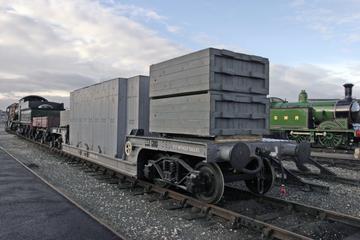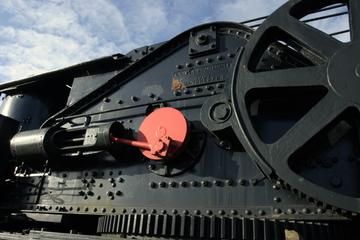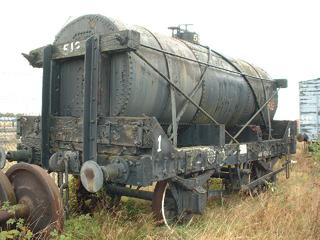
'Warflat' 50-ton bogie flat wagon, 1940
- manufacturer:
- Metropolitan-Cammell Carriage & Wagon Company Ltd

Railway wagon, No 161042, 50-ton bogie flat wagon, Warflat WC, used by the War Department and British Railways built by Metropolitan-Cammell Carriage & Wagon Company Limited, 1940. Later rebuilt to diagram number BR Wagon 73, number built 60. Length over buffers: 43' 10 1/2"; width 7' 10"; height 5'.
The Warflat is one of a series of special wagons created for the transport of tanks and other military vehicles by rail in both Britain and on the continent.
The need to transport tanks by rail emerged during the First World War. For this purpose, a batch of 250 London & North Western Railway (LNWR) ‘Parrot’ 40-ton bogie wagons was built for the War Office, while in 1918, 200 purpose-designed 35-ton ‘Rectank’ bogie wagons featuring a shallow well were also built. Both had robust girder-like solebars to support the weight of heavy military vehicles and equipment, a walking surface of timber planking, and securing rings. Lifting jacks under the buffer beams supported the wagon ends as tanks drove over them. After the war, many Parrots were purchased by railway companies for conversion to bolsters to carry long loads. Rectanks and Parrots were also used during the Second World War. Generally, trains carrying tanks were out-of-gauge loads, and were routed accordingly.
The Warflat was in essence a Second World War update of the Parrot. Initially 45-ton capacity, the new wagons also featured lifting jacks, and securing rings, while a subsequent batch with strengthened solebars could carry a weight of 50 tons. This reflected the fact that tanks were increasing in weight as thicker armour was needed to counter developments in firepower on the battlefield. Ramp wagons were later designed with a removable axle, allowing tanks to drive straight onto the wagons from the end without fixed loading facilities. A later, revised design of Warflat was built at Shildon Works for the Ministry of Defence.
Built in 1940, No W161042 was one of several 50-ton wagons built by Metro-Cammell of Birmingham for the War Department and was registered with the LMS as ‘Private Owner’ wagon No 87. It is one of 60 surplus wagons acquired by British Railways (Western Region) in 1961 and reconditioned at Swindon Works under Lot No 3416 to diagram 2/073. It appears to have remained a flat wagon, albeit with the lifting jacks removed. Some were converted to concrete or steel beam carriers by adding bolsters, while others were converted to strip coil wagons.
Details
- Category:
- Locomotives and Rolling Stock
- Object Number:
- 1988-7015
- Materials:
- metal (unknown)
- Measurements:
-
length over buffers: 13373 mm,
height: 1524 mm
width: 2388 mm
- type:
- railway wagon
- credit:
- British Rail, Add. not known




